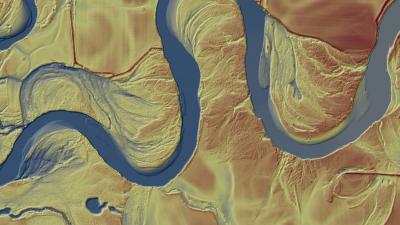A major source of flood losses is damage to roads, bridges, and other infrastructure caused by fluvial or river erosion - where flood waters erode stream and river banks or even change course, shifting where they flow across the landscape. A challenge working with fluvial systems has been predicting where a shift will occur. We are developing a data fusion approach to access the sensitivity of FEH in different physiographic regions of Indiana through the use of in situ and remote sensor data. Specifically the 2011-2013 Indiana Orthophotography, LiDAR, and Elevation Dataset (IMAGIS), and alluvial soil layers generated by the Natural Resources Conservation Service (NRCS). These data provide a tremendous amount of information allowing us to determine where the stream might potentially erode at both the watershed and stream reach scale.
Using LIDAR to improve fluvial erosion hazard (FEH) mapping
Tuesday, February 12, 2013



